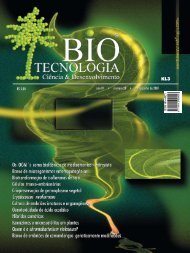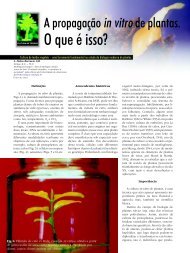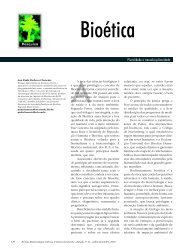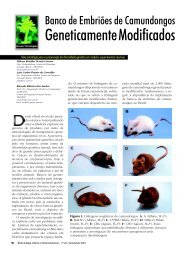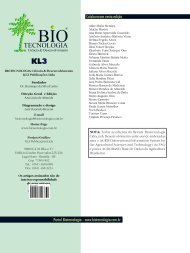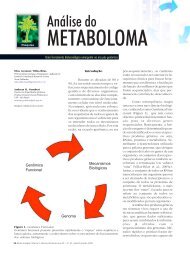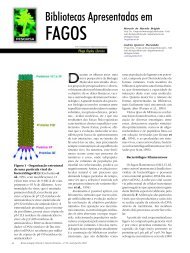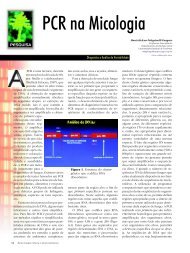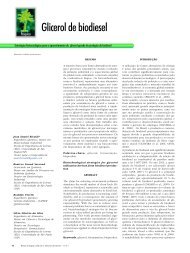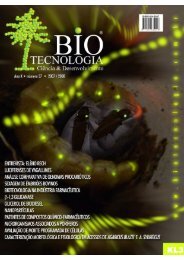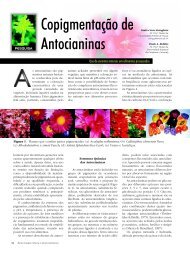Aprendendo com as agrobacterias - Biotecnologia
Aprendendo com as agrobacterias - Biotecnologia
Aprendendo com as agrobacterias - Biotecnologia
You also want an ePaper? Increase the reach of your titles
YUMPU automatically turns print PDFs into web optimized ePapers that Google loves.
dos por Denolf et al. (1993a,b), utilizando<br />
<strong>as</strong> proteín<strong>as</strong> Cry1Ac e Cry1Ba<br />
(marcad<strong>as</strong> <strong>com</strong> molécul<strong>as</strong> de biotina e<br />
de iodo radioativo), em larv<strong>as</strong> de Ostrinia<br />
nubilalis, revelaram que ess<strong>as</strong> toxin<strong>as</strong><br />
se ligam a diferentes receptores<br />
intestinais, sugerindo que a utilização<br />
simultânea dess<strong>as</strong> proteín<strong>as</strong> pode apresentar<br />
um efeito inseticida sinérgico<br />
contra O. nubilalis.<br />
Relacionando o estudo dos receptores<br />
in vitro e a análise da toxicidade<br />
in vivo, pode-se inferir que os métodos<br />
de detecção de receptores membranares<br />
podem ser aplicados na seleção<br />
d<strong>as</strong> proteín<strong>as</strong> ativ<strong>as</strong> contra insetos,<br />
havendo uma correlação positiva entre<br />
<strong>as</strong> análises in vitro e in vivo. Porém,<br />
para determinar a Concentração Letal<br />
Média (CL 50<br />
) de uma proteína Cry fazse<br />
necessário o bioensaio uma vez que<br />
<strong>as</strong> ligações d<strong>as</strong> proteín<strong>as</strong> aos receptores<br />
podem variar em concentração e<br />
afinidade, <strong>com</strong>o já descrito por diversos<br />
autores, para diferentes espécies<br />
de insetos (Denolf et al., 1993a; Van<br />
Rie et al., 1990; Fiuza et al., 1996; Lee<br />
et al., 1996; Hua et al., 2001). Também<br />
há estudos demonstrando que <strong>as</strong> proteín<strong>as</strong><br />
Cry tóxic<strong>as</strong> aos insetos correspondem<br />
àquel<strong>as</strong> que se ligam de forma<br />
irreversível aos receptores d<strong>as</strong> célul<strong>as</strong><br />
epiteliais do inseto-alvo (Liang et<br />
al., 1995).<br />
No contexto, controle microbiano<br />
de insetos, a espécie Bacillus thuringiensis<br />
oferece <strong>as</strong> melhores alternativ<strong>as</strong><br />
à produção de biopesticid<strong>as</strong> e à<br />
engenharia genética de plant<strong>as</strong>. Sendo<br />
<strong>as</strong>sim, é fundamental avaliar o espectro<br />
de ação e a especificidade d<strong>as</strong><br />
proteín<strong>as</strong> potencialmente inseticid<strong>as</strong><br />
e, nesse sentido, a análise in vitro dos<br />
receptores membran<strong>as</strong> pode ser considerada<br />
uma ferramenta indispensável<br />
face ao grande número de isolados,<br />
cep<strong>as</strong> e proteín<strong>as</strong> de B. thuringiensis<br />
já identificados, que representam um<br />
potencial no manejo de insetos-praga.<br />
5. Agradecimentos<br />
À equipe Biotrop do Centre Internationale<br />
de Recherche Agronomique<br />
pour le Dévélopement (Montpellier,<br />
França), especialmente a Drª Nicole<br />
Michaux-Ferriere, <strong>as</strong>sim <strong>com</strong>o aos pesquisadores<br />
Dr. Jeroen Van Rie (Plant<br />
Genetic Systems, Ghent, Bélgica) e ao<br />
Dr. Jean-François Charles (Institut P<strong>as</strong>teur,<br />
Paris, França), por su<strong>as</strong> contribuições<br />
nessa pesquisa.<br />
6. Referênci<strong>as</strong><br />
Bibliográfic<strong>as</strong><br />
ARMSTRONG, J. L.; ROHRMANN, G. F.<br />
& BEAUDREAU, G. S. 1985. Deltaendotoxins<br />
of Bacillus thuringiensis<br />
subspecies israelensis. Journal<br />
Bacteriology, 161: 39-46.<br />
ARONSON, A.; HAN, E.; McGAUGHEY,<br />
W. & JOHNSON, D. 1991. The<br />
solubility of inclusion proteins from<br />
Bacillus thuringiensis is depend<br />
upon protoxin <strong>com</strong>position and is<br />
a factor in toxicity to insects. Applied<br />
Environmental Microbiology,<br />
57:981-986.<br />
BAYER, E. & WILCHECK, M. 1990.<br />
Protein biotinylation. Methods in<br />
Enzymology. 184: 138-159.<br />
BOETS, A.; JANSENS, S.; DENOLF, P.;<br />
PEFEROEN, M.; DEGHEELE, D.;<br />
VAN RIE, J. 1994. Sequential<br />
observations of toxin distribution<br />
and histopathological effects of<br />
CryIIIA in the gut of intoxicated<br />
Leptinotarsa decemlineata larvae.<br />
XXVIIth Annual Meeting of the<br />
Society for Invertebrate Pathology,<br />
p. 377.<br />
BRADFORD, M. 1976. A rapid and<br />
sensitive method for the<br />
quantitation of microgram<br />
quantities of protein utilizing the<br />
principle of protein-dye binding.<br />
Analytical Biochemistry. 72 : 248-<br />
254.<br />
BRANDTZAEG, P. 1982. Tissue preparation<br />
methods for imunocytochemistry.<br />
In: Bullock G. & Petruz<br />
P., Techniques in imunocytochemistry.<br />
Academic Press, London.<br />
pp. 49-51.<br />
BRAVO, A.; JANSENS, S.; PEFEROEN,<br />
M. 1992a. lmmunocytochemical<br />
localization of Bacillus thuringiensis<br />
insecticidal crystal proteins in<br />
intoxicated insects. J. Invertebr.<br />
Pathol 60:237-246.<br />
BRAVO, A.; HENDRICKX, K.; JANSENS,<br />
S.; PEFEROEN, M. 1992b.<br />
Immunocytochemical analysis of<br />
specific binding of Bacillus<br />
thuringiensis insecticidal crystal<br />
proteins to lepidopteran and<br />
coleopteran midgut membranes.<br />
J. Invertebr. Pathol 60:247-253.<br />
BURKE, B.; GRIFFIHS, G.; REGGIO,<br />
H.; LOUVARD, D. & WARREN, G.<br />
1982. A monoclonal antibody<br />
against a 135-K Golgi membrane<br />
protein. European Molecular<br />
Biology Organization Journal, 1:<br />
1621-1628.<br />
CASTILHOS-FORTES, R.;<br />
MATSUMURA, A. T. S.; DIEHL, E. &<br />
FIUZA, L. M. 2002. Susceptibility<br />
of N<strong>as</strong>utitemes ehrhadti (Isoptera:<br />
Termitidae) to Bacillus<br />
thuringiensis. Brazilian Journal<br />
of Microbiology, 33: 221-224.<br />
CHOMA, C. T. & KAPLAN, H. 1990.<br />
Folding and unfolding of the<br />
protoxin from Bacillus<br />
thuringiensis: Evidence that the<br />
Toxic Moiety is present in a Active<br />
Conformation. Biochemistry, 29:<br />
10971-10977.<br />
CRICKMORE, N.; ZEIGLER, D.R.;<br />
FEITELSON, J.; SCHENEPF, E; VAN<br />
RIE, J.; LERECLUS, D.; BAUM, J.;<br />
DEAN, D. 1998. Revision of the<br />
nomenclature for the Bacillus<br />
thuringiensis pesticidal crystal<br />
proteins. Microbiol. and Mol. Biol.<br />
Rev. 62(3):807-813.<br />
DAGNELIE, P. 1975. Théorie et<br />
Méthodes statistiques, applications<br />
agronomiques. Les Presses<br />
Agronomiques de Gembloux, vol.<br />
II, pp. 56-57.<br />
DE MAAG, R.; BOSCH, D. ; STIEKEMA,<br />
W. 1999. Bacillus thuringiensis<br />
toxin-mediated insect resistance<br />
in plants. Trends Plant Sci. 4: 9-13.<br />
DENOLF, P.; JANSENS, S.; PEFEROEN,<br />
M.; DEGHEELE, D.; VAN RIE, J.<br />
1993a. Two different Bacillus<br />
thuringiensis delta-endotoxin<br />
receptors in the midgut brush<br />
border membrane of the European<br />
corn borer, Ostrinia nubilalis. Appl.<br />
Environ. Microbiol 59(6):1828-<br />
1837.<br />
DENOLF, P.; JANSENS, S.; VAN HOUDT,<br />
S.; PEFEROEN, M.; DEGHEELE, D.;<br />
VAN RIE, J. 1993b. Biotinylation of<br />
Bacillus thuringiensis insecticidal<br />
crystal proteins. Appl. Environ.<br />
Microbiol. 59(6):1821-1827.<br />
ENDO, Y. & NISHIITSUTSUJI-UWO, J.<br />
1980. Mode of Action of Bacillus<br />
thuringiensis delta-endotoxin:<br />
Histopathological Changes in the<br />
Silkworm Midgut. Journal<br />
88 <strong>Biotecnologia</strong> Ciência & Desenvolvimento n.32 - janeiro/junho 2004



